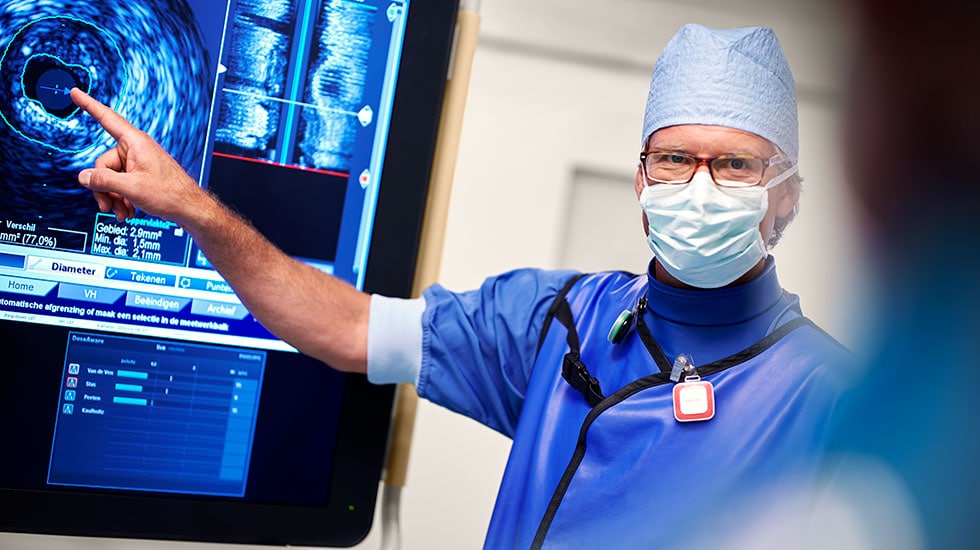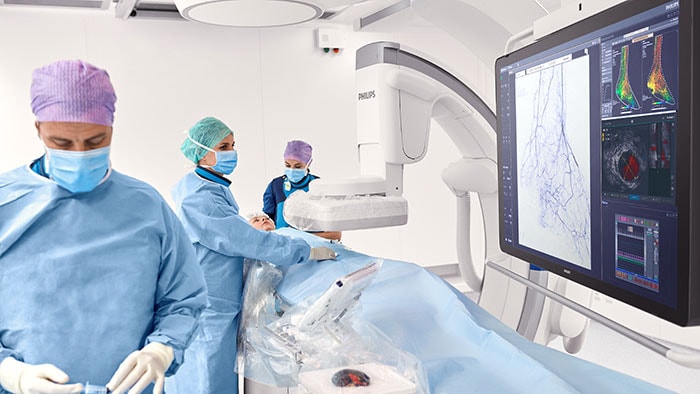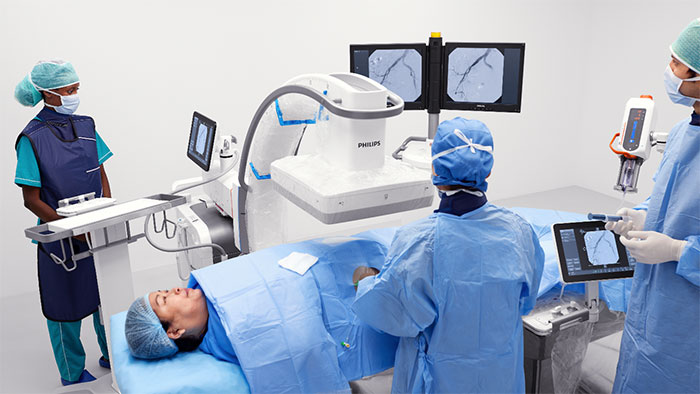Multidisciplinary panel of experts from prominent cardiovascular societies advocate for broader adoption of IVUS in peripheral interventions to improve patient care
Jan 11, 2024 | 3 minute read
Amsterdam, the Netherlands – Royal Philips, a global leader in health technology, today announced that a group of multidisciplinary cardiovascular specialists from prominent medical societies have issued a joint expert opinion on the advantages of intravascular ultrasound (IVUS) use in peripheral arterial and deep venous interventions compared with using angiography alone. The use of IVUS remains low despite growing clinical evidence and increasing inclusion in practice guidelines.

The document, published simultaneously in the Journal of the Society for Cardiovascular Angiography and Interventions (JSCAI), Journal of Vascular and Interventional Radiology (JVIR) and Journal of Vascular Surgery-Vascular Insights (JVS-Vascular Insights) reviews current evidence base and clinical experience for IVUS-guided interventions by a roundtable panel consisting of 15 physicians from six cardiovascular speciality societies [1-3]. The goals of the panel discussion were to assess the current state of IVUS utilization in lower extremity revascularization, identify evidence gaps and determine how IVUS can improve care of patients with peripheral arterial and deep venous pathology.
The panel looks forward to working with our collective societies to increase access to training with IVUS, support strong reimbursement to allow for wider adoption, and work to incorporate IVUS into clinical guidelines.
Lead author Eric A. Secemsky, MD, Interventional Cardiologist at Beth Israel Deaconess Medical Center and Assistant Professor of Medicine at Harvard Medical School, Boston USA:
“While the panel acknowledges that additional clinical evidence is critical to advancing the utilization of IVUS, the current data reviewed as part of this expert roundtable supports greater use of IVUS in contemporary clinical practice. The panel looks forward to working with our collective societies to increase access to training with IVUS, support strong reimbursement to allow for wider adoption, and work to incorporate IVUS into clinical guidelines.”
Peripheral arterial disease (PAD) and deep venous disease effect nearly 200 million people worldwide, including approximately 40 to 45 million Americans [4]. Minimally invasive treatments for peripheral vascular disease (PVD) are increasingly common, but traditional imaging techniques like angiography have limitations, including 2-dimensional projections of 3-dimensional vasculature, which can complicate diagnosis and intraprocedural optimization.
Significant value for procedural staff and patients
Published today as “Intravascular Ultrasound Use in Peripheral arterial and Deep Venous Interventions: Multidisciplinary Expert Opinion From SCAI/AVF/AVLS/SIR/SVM/SVS,” the panel acknowledged that IVUS utilization remains low despite growing data and clinical experience demonstrating benefits of IVUS in contemporary peripheral interventions. Compared with angiography alone, the document highlights advantages of IVUS including identification of plaque burden and morphology, lesion characteristics as well as stent sizing and positioning which translate into improvements in procedural safety and long-term patient outcomes.
There was agreement among experts that the main evidence gap for peripheral arterial use was determining if uptake in practice can improve procedural success. Importantly, the authors also noted that the reductions in radiation exposure in an IVUS-guided procedure has significant value for both operative staff and patients that may on its own be sufficient to justify use. Besides positive impact on radiation safety and patient contrast load, IVUS may also play an important role in the use in novel technologies, like ultrasound renal denervation – a minimally invasive therapy option for the treatment of uncontrolled hypertension [5] involving the use of ultrasound energy to treat overactive renal nerves*, which can help lower high blood pressure [5,6].
The committee also identified several barriers to increased IVUS use including limitations with access to technology and training, restrictive reimbursement and perceptions around added time. The joint multidisciplinary expert opinion is timed to recent policy proposals by The Society for Cardiovascular Angiography and Interventions (SCAI), American College of Cardiology (ACC), Society of Interventional Radiology (SIR), Society for Vascular Surgery (SVS) and Outpatient Endovascular and Interventional Society (OEIS) for broader reimbursement of IVUS in modern interventional practice [7,8].
Chris Landon, Business Leader Image Guided Therapy Devices at Philips:
“IVUS is a technology that has demonstrated an ability to both support safer procedures for patients and procedural staff alike including reductions in radiation exposure. As the global leader in IVUS solutions, we are grateful for the rigorous multidisciplinary approach to developing expert consensus on the value of IVUS and we look forward to working with all stakeholders to standardize the use of IVUS and reduce the barriers preventing utilization.”
Using a miniaturized ultrasound transducer mounted on the tip of a catheter, IVUS captures real-time images inside the vessel. IVUS imaging enables physicians to formulate patient-specific treatment plans. Philips is the global leader in IVUS solutions.
Presentation
Multidisciplinary expert opinion will be presented at the International Symposium of Endovascular Therapies (ISET) annual meeting on Thursday, January 25th at 8:00 am ET. You can learn more about the discussion and register for the event at Session Agenda | The International Symposium on Endovascular Therapy (hmpglobalevents.com)
Sources [1] Secemsky EA, Aronow HE, Kwolek CJ, et al. Intravascular ultrasound use in peripheral arterial and deep venous interventions: multidisciplinary expert opinion from SCAI/AVF/AVLS/SIR/ SVM/SVS. J Soc Cardiovasc Angiogr Interv. Published online January 9, 2024. doi: 10.1016/j.jscai.2023.101205.
[2] Secemsky, EA, Aronow HD, Kwolek, CJ, et al. Intravascular ultrasound use in peripheral arterial and deep venous interventions: multidisciplinary expert opinion from SCAI/AVF/AVLS/SIR/SVM/SVS. J Vasc Interv Radiol 2024. https://www.jvir.org/; published online January 9, 2024. doi: 10.1016/j.jvir.2023.11.006
[3] Secemsky, EA, Aronow HD, Kwolek, CJ, et al. Intravascular ultrasound use in peripheral arterial and deep venous interventions: multidisciplinary expert opinion from SCAI/AVF/AVLS/SIR/SVM/SVS. JVS-Vascular Insights. Published online January 9, 2024. doi: 10.1016/j.jvsvi.2023.100033.
[4] Benjamin EJ, Muntner P, Alonso A, Bittencourt MS, Callaway CW, Carson AP, Chamberlain AM, Chang AR, Cheng S, Das SR, Delling FN, Djousse L, Elkind MSV, Ferguson JF, Fornage M, Jordan LC, Khan SS, Kissela BM, Knutson KL, Kwan TW, Lackland DT, Lewis TT, Lichtman JH, Longenecker CT, Loop MS, Lutsey PL, Martin SS, Matsushita K, Moran AE, Mussolino ME, O'Flaherty M, Pandey A, Perak AM, Rosamond WD, Roth GA, Sampson UKA, Satou GM, Schroeder EB, Shah SH, Spartano NL, Stokes A, Tirschwell DL, Tsao CW, Turakhia MP, VanWagner LB, Wilkins JT, Wong SS, Virani SS., American Heart Association Council on Epidemiology and Prevention Statistics Committee and Stroke Statistics Subcommittee. Heart Disease and Stroke Statistics-2019
Update: A Report From the American Heart Association. Circulation. 2019 Mar 05;139(10):e56-e528. [PubMed]
[5] https://www.radcliffecardiology.com/video-index/latest-ultrasound-renal-denervation
[6] https://www.pennmedicine.org/for-patients-and-visitors/find-a-program-or-service/heart-and-vascular/interventional-cardiology/peripheral-interventions/renal-denervation
[7] https://scai.org/scai-asks-aetna-update-clinical-policies-atherectomy-and-intravascular-ultrasound-ivus
[8] https://cardiovascularbusiness.com/topics/clinical/interventional-cardiology/cardiologists-lead-push-aetna-reconsider-restrictive-inconsistent-reimbursement-proposals










